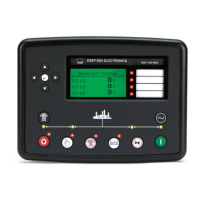= There is no alternator in the system, it is an engine only application
= An alternator is fitted to the engine, it is a generator application.
Poles The number of poles on the alternator
VT Fitted
= The voltage sensing to the controller is direct from the alternator
= The voltage sensing to the controller is via Voltage Transformers (VTs or PTs)
This is used to step down the generated voltage to be within the controllers voltage
specification.
By entering the Primary and Secondary voltages of the transformer, the controller
will display the Primary voltage rather than the actual measured voltage.
This is typically used to interface the DSE module to high voltage systems (ie 11kV)
but can also be used on systems such as 600V ph-ph.
4.7.1.1 GENERATOR CONTACTOR ALARM
Generator Contactor
Alarm
= Generator fail to close alarm is disabled
= If the generator breaker does not close, within the time alarm an alarm is
raised.
4.7.1.2 GENERATOR PHASE ROTATION
Generator Phase
Rotation
IEEE 37.2 – 47 phase
sequence relay
= Generator phase rotation is not checked.
= An electrical trip alarm is generated if the phase rotation is not as configured.
4.7.1.3 GENERATOR RATING
The Generator kW and kVAr rating must be correctly set.
The values you set here are the kW and kVAr, NOT the kVA or Power Factor!
These values are used for many functions including Generator Power functions and Load Share functions.
Calculating the VAr rating of a genset
• Most generators are rated for a power factor (W \ VA) of 0.8
• From Pythagoras :
Cos Φ = W / VA
Cos Φ = 0.8
Φ = Cos-1 0.8 = 36.87°
• From this we can calculate the VAr rating of the typical 0.8 pf rated generator as :
Tan Φ = VAr / W
VAr = Tan 36.87 x W
VAr = 0.75 x W
• Or to simplify this, the VAr rating of a 0.8 pf rated generator is ¾ of the W rating
(kVAr rating = 75% of kW rating)

